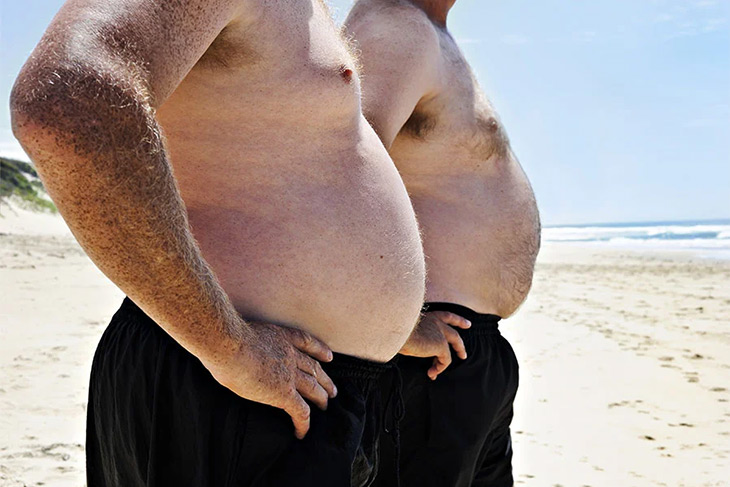The Aussie beer belly: Is it a myth?

Is there such a thing as a beer belly? Can drinking too much alcohol make your body store more fat around your stomach area?
While there’s a lot of hype about sugar being poison and carbs being fattening, alcohol often gets overlooked as a possible key contributor to obesity in adults.
Alcohol plays a complex role in Australian society. Most of us drink socially, for enjoyment or for relaxation and most also drink at a level that cause few problems. But what is perhaps less well understood is the role that the evening tipple plays in obesity.
Why do men and women get a beer belly?
It’s not necessarily beer that can cause a protruding gut, but too many kilojoules overall – whether from alcohol, large food portions, and not enough exercise – that can increase belly fat.
However, excessive alcohol does seem to be associated with fat around the midsection.
Professor Manny Noakes, Research Director of the CSIRO’s Food and Nutrition Flagship and co-author of the CSIRO Total Wellbeing Diet, explains:
"The issue is that people don’t recognise how many kilojoules are in alcoholic drinks and that combined with an increase in appetite results in a kilojoule surplus which leads to more fat deposition. For men, this surplus is preferentially deposited in the belly."
So there it is: at least for males, there is some truth to the myth that drinking beer can give you a big gut.
A recent study showed that beer intake above moderate levels (>500 mL/day) may be linked with abdominal obesity. Another study, published in the European Journal of Nutrition found elevated alcohol consumption (more than 3 drinks per day) was associated with risk of abdominal obesity.
How alcohol adds to kilojoule intake
When you look at the kilojoule intake of alcohol, it’s easy to see why too much alcohol intake can contribute to getting a beer gut. In addition, alcohol can stimulate your appetite, causing you to eat more.
Accredited Practicing Dietitian, Nicole Senior, says, “While carbohydrate contains 16 kilojoules (kJ) per gram and protein contains 17 kJ per gram, alcohol contains 29 kJ per gram. A standard drink contains 10 grams of alcohol in Australia, so you have 290 kJ in the glass even before you consider the kilojoules from any other ingredients such as the sugar in mixers, or cream in cocktails.”
Compare that to the average daily kilojoule intake (8700kJ) and you’ll understand that a couple of drinks in the evening can increase your kilojoule intake drastically over a week, a month and a year.
How do I know if my belly is putting my health at risk?
The size of your waist is a good measure. For men, a waist measurement over 94 cm is a cause for concern. While for women, a waist measurement over 80 cm indicates increased risk of obesity related health conditions.
You should also watch your intake of alcohol and figure out how much you actually do drink.
The Australian Dietary Guidelines recommend drinking no more than 2 standard drinks per day to reduce the lifetime risk of harm from alcohol-related disease and injury.
However, a standard drink is not necessarily what you get served when you order a glass of wine at the bar, as you can see from this table:
| Drink | Standard Drinks |
| Average glass (150ml) of red wine (13.5%) | 1.6 |
| Average glass (150ml) of white wine (11.5%) | 1.4 |
| Average glass (150ml) of Champagne (12%) | 1.4 |
| Schooner (425ml) of full strength beer (4.8%) | 1.6 |
| Schooner (425ml) of mid strength beer (3.5%) | 1.2 |
| Can (375ml) of pre-mixed spirits (5%) | 1.5 |
Apart from carrying unnecessary kilos, abdominal obesity is linked to various health conditions. These include a higher risk of cardiovascular disease, type 2 diabetes and certain types of cancer.
How to get rid of a beer belly
Ab crunches or any other abs-focused exercise alone isn’t going to beat the bulge. What you need is a multi-pronged attack of diet, lifestyle and exercise.
In terms of diet, portion control is crucial. You can have the healthiest diet in the world but if you’re eating too much overall, you simply can’t expect the abdominal fat to budge.
Also, as alcohol adds a considerable amount to your total kilojoule intake, and doesn’t satisfy your appetite, ensure you plan around social occasions when you know you might be drinking. Eat a small meal beforehand – ideally consisting of low GI carbs and some form of protein so you feel full and are less tempted to indulge in snacks while you’re out. Finally, alternate drinks with glasses of water to quench your thirst.
While exercise is crucial for a tight tummy, the answer isn’t endless sit-ups. Interval training, where you alternate between high and low intensity activity, is an effective way to increase your energy expenditure, thus helping with carving out that waistline. You don’t need to be regimented, you just need to exert yourself 5, 10 or 15 times during a walk or run. Then build up the intensity as you get fitter.
Are you trying to lose weight? Read our comprehensive guide on weight loss to understand where to begin, what happens when you lose weight, and what doesn't work when it comes to dieting.
